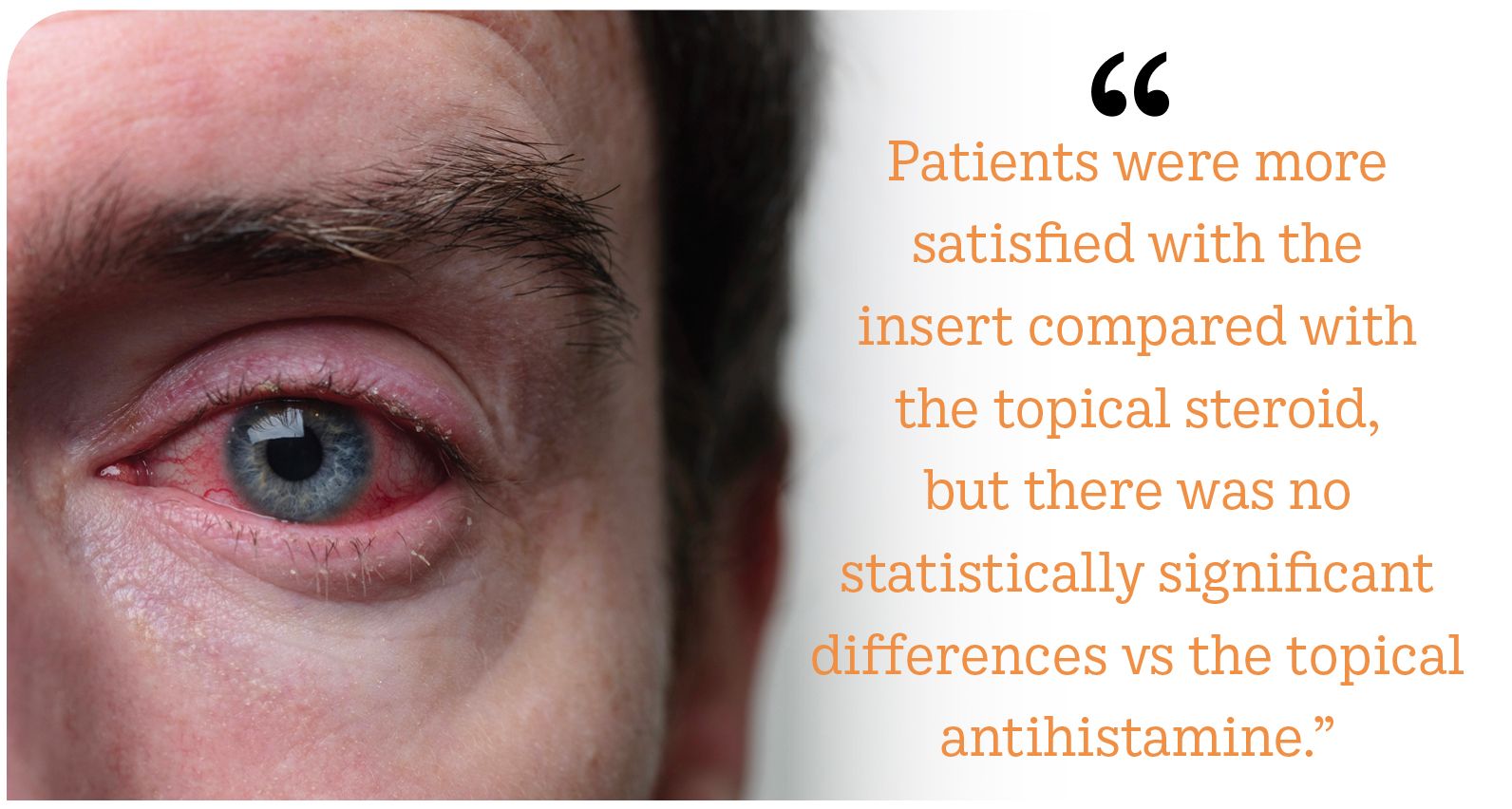Adjunct role for Dextenza insert in allergic conjunctivitis
The insert is a convenient method to reduce ocular itching.
(Image credit: Adobe Stock / Oporty786)

Allergic conjunctivitis (AC), an allergen-induced inflammatory-mediated condition, places a significant burden on patients and health care practices.1,2 Unfortunately, current topical drop therapies have limitations, including potential for noncompliance and toxicity due to preservatives that can wreak havoc on the ocular surface.3,4
Dropless option
Topical ophthalmic steroids are effective in treating AC, yet physicians report infrequent use due to concerns surrounding adverse effects and risk of abuse associated with long-term use.5,6 Dextenza (dexamethasone ophthalmic insert 0.4 mg; Ocular Therapeutix, Inc) is a physician-administered, hydrogel-based, intracanalicular insert that contains 0.4 mg dexamethasone in a hydrogel matrix (Elutyx).7 Designed as an alternative to conventional steroid eye drops, the insert provides tapered therapy for up to 30 days. The insert’s FDA-approved indications of pain and inflammation following ocular surgery were expanded to include ocular itching associated with AC in 2021. In the pivotal phase 3 study, dexamethasone ophthalmic insert 0.4 mg showed statistically significant lower mean ocular itching scores compared with vehicle insert at all time points (P < .001) evaluated.

To learn more about how this dropless therapy compares with topical steroids and topical antihistamines for treating ocular itching associated with AC, 30 patients were randomly assigned to receive the insert in the eye with worse symptoms and topical loteprednol etabonate ophthalmic solution 0.2% (Alrex; Bausch + Lomb) or olopatadine hydrochloride ophthalmic solution 0.7% (Pazeo; Novartis) in the other (15 patients in each arm).8 My colleagues and I sought to compare patient-reported and clinical outcomes and preference of therapy in the 2 eyes over 30 days. Patients were asked to log activities, potential exposure to allergens, and symptoms in a diary, and local pollen counts and air quality index were logged daily. Patients were examined on days 3, 8, 15, and 30 after randomization for a slit lamp examination and assessment of symptoms. An assessment of patient-reported treatment preference was completed on day 30.
Results
Regarding both the amount and speed of symptom improvement, patients were more satisfied with the insert compared with the topical steroid (P = .024), but there was no statistically significant difference vs the topical antihistamine (P = .293) in terms of satisfaction. Patients reported that the insert was more convenient than topical therapy, and said they were more likely to recommend it to a friend compared with topical steroid (P < .001), but again there was no statistically significant difference compared with the topical antihistamine (P = .104). Itching severity was reduced more with the insert compared with the topical steroid (P = .007) but not the topical antihistamine (P = .096), and redness generally showed greater improvement with the insert compared with both topical therapies (P < .001 for each) (Figures 1–3).
Importantly, the mean IOP was comparable throughout all visits between the dexamethasone insert and loteprednol, and it was not clinically significantly different between the insert-treated eyes and
olopatadine-treated eyes. Although the dexamethasone ophthalmic insert 0.4 mg is routinely placed in the operating room or ambulatory surgery center after ocular surgery, it can be placed in the office at the slit lamp once the punctum is optimally dilated, as was done for all the patients in our study.
Conclusion
This study showed that if a physician is prescribing a steroid for AC, having dexamethasone ophthalmic insert 0.4 mg as an option for these patients is useful. It may also provide relief as an adjunct for patients who are not getting the response they would like from their normal antihistamine or mast-cell stabilizer drops. The insert could offer a solution for patients who present during peak allergy season claiming that their usual drops are not offering sufficient relief of symptoms.
References
1. Leonardi A, Castegnaro A, Valerio AL, Lazzarini D. Epidemiology of allergic conjunctivitis: clinical appearance and treatment patterns in a population-based study. Curr Opin Allergy Clin Immunol. 2015;15(5):482-488. doi:10.1097/ACI.0000000000000204
2. Rosario N, Bielory L. Epidemiology of allergic conjunctivitis. Curr Opin Allergy Clin Immunol. 2011;11(5):471-476. doi:10.1097/ACI.0b013e32834a9676
3. Winfield AJ, Jessiman D, Williams A, Esakowitz L. A study of the causes of non-compliance by patients prescribed eyedrops. Br J Ophthalmol. 1990;74(8):477-480. doi:10.1136/bjo.74.8.477
4. Rosin LM, Bell NP. Preservative toxicity in glaucoma medication: clinical evaluation of benzalkonium chloride-free 0.5% timolol eye drops. Clin Ophthalmol. 2013;7:2131-2135. doi:10.2147/OPTH.S41358
5. Bielory BP, O’Brien TP, Bielory L. Management of seasonal allergic conjunctivitis: guide to therapy. Acta Ophthalmol. 2012;90(5):399-407. doi:10.1111/j.1755-3768.2011.02272.x
6. Bielory L, Meltzer EO, Nichols KK, Melton R, Thomas RK, Bartlett JD. An algorithm for the management of allergic conjunctivitis. Allergy Asthma Proc. 2013;34(5):408-420. doi:10.2500/aap.2013.34.3695
7. Dextenza. Prescribing information. Ocular Therapeutix Inc; 2019.
8. Reich S. Intracanalicular dexamethasone insert versus topical steroid or antihistamine therapy for treatment of allergic conjunctivitis. Presented at: 2022 American Society of Cataract and Refractive Surgery Annual Meeting; April 22-26, 2022; Washington, DC.
9. Chang R. Real-world safety analysis of an intracanalicular dexamethasone insert using the IRIS Registry (Intelligent Research in Sight). Presented at: 2022 American Society of Cataract and Refractive Surgery Annual Meeting; April 22-26, 2022; Washington, DC.
